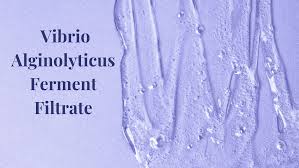
Vibrio Alginolyticus Ferment Filtrate in Skincare
Vibrio Alginolyticus Ferment Filtrate is an ingredient used in some skincare products that comes from the fermentation process of a marine microorganism called Vibrio alginolyticus. There are many different ferments found in skin care, and this one is found in products made by SkinMedica. What about this ferment make it beneficial to the skin?
Vibrio Alginolyticus Ferment Filtrate Benefits
In skincare, Vibrio Alginolyticus Ferment Filtrate offers several benefits: it functions as a potent antioxidant to help neutralize free radicals and protect skin from environmental damage. It also has anti-inflammatory properties to reduce skin redness and irritation. Additionally, it provides hydration by attracting and binding moisture to the skin.
How is it sourced?
V. alginolyticus is a gram-negative, aerobic bacteria that is commonly found in marine environments. The ferment from this bacteria is obtained through a laboratory fermentation process under controlled conditions.
active compounds of vibrio alginolyticus ferment filtrate
Active Compounds
Research has identified specific compounds in Vibrio Alginolyticus that contribute to its effects. These include polysaccharides that help hydrate skin, amino acids that nourish skin, and peptide complexes that can protect against UV radiation.
Polysaccharides in Vibrio Alginolyticus Ferment Filtrate
The polysaccharides found in the Vibrio Alginolyticus ferment act as excellent humectants and moisture-binders for the skin. They pull moisture from the atmosphere and from deeper skin layers to the surface, infusing hydration into thirsty cells. These sugar-based molecules essentially attach to water molecules, softening and smoothing the skin through deep and lasting hydration. Their moisture-binding nature helps retain hydration, preventing water loss even in dry conditions for supple, dewy skin.
Peptides in Vibrio Alginolyticus Ferment Filtrate
Vibrio Alginolyticus also produces various peptides that benefit skin by signaling to cells. Research indicates the peptide compounds in the ferment stimulate the production of structural proteins like collagen and hyaluronic acid. This helps plump the appearance of skin and reduces signs of aging related to protein breakdown like wrinkles and loss of firmness.
products with vibrio alginolyticus ferment filtrate
Uses
Vibrio Alginolyticus Ferment Filtrate’s combination of humectants, emollients, and other moisturizing ingredients make it an ideal ingredient to treat dull, dehydrated skin in need of rich hydration. By drawing moisture into thirsty skin and reinforcing the moisture barrier, products containing this ingredient can revive dreary complexions to refresh a radiant, healthy glow. The ferment filtrate can also provide relief for painfully chapped and cracked lips when incorporated into lip treatments. Its polysaccharides deeply moisturize dry flaky skin on and around lips while oligopeptides strengthen tissue to smooth and soften texture. Additionally, the filtrate’s ability to facilitate absorption can help deliver other beneficial skincare nutrients deeper where they are needed most. For this versatility, the marine bacteria extract has become a coveted component of many high-end anti-aging creams, serums and masks striving to restore youthful vitality.
Products with Vibrio Alginolyticus Ferment Filtrate
Products featuring this marine bacterial ferment are great for sensitive, stressed skin in need of antioxidant protection and deep hydration. The ingredient is often found in serums, ampoules, lotions and essences targeting signs of aging like wrinkles and uneven texture.
Vibrio Alginolyticus Ferment Filtrate is found in the skin lightening serum SkinMedica Lytera 2.0. It helps sooth inflammation which helps prevent formation of melanin pigment.
The Vibrio Alginolyticus Ferment Filtrate works synergistically with the hyaluronic acid in the SkinMedica HA5 Rejuvenating Hydrator for enhanced hydration benefits:
Boosts hyaluronic acid effectiveness – The peptides and polysaccharides in the ferment filtrate act as humectants and moisture magnets, helping to draw moisture into the skin. This allows the HA in the formula to attract and bind even more water.
Enhances nutrient absorption – The amino acids in the filtrate facilitate the absorption of the HA and other nutrients deep into the skin for better hydration and nourishment.
Supports surface hydration – While the smaller HA chains penetrate into the dermis, the ferment filtrate’s occlusive barrier property helps seal hydration on the surface of the epidermis provided by the larger HA molecules.
Smooths and reinforces moisture barrier – The gentle exfoliation of the filtrate removes dead skin cells to allow richer hydration while the nutrients strengthen the moisture barrier to prevent moisture loss.
Overall, the marine bacteria extract’s moisturizing mechanisms, exfoliating ability, and nutrient content make it the perfect addition to maximize the thirst-quenching action of a concentrated hyaluronic serum like SkinMedica HA5. It drives hydration on multiple fronts for visibly plump, supple skin.
SkinMedica HA5 Smooth and Plump Lip System has this ferment to help hydrate dry lips.
Vibrio Alginolyticus Ferment Filtrate can help boost lip hydration in several key ways:
Humectant properties – The polysaccharides and peptides in the ferment filtrate act as humectants. This means they attract and bind moisture to the skin, softening and smoothing dry flaky skin on and around the lips.
Occlusive effect – The filtrate creates a thin protective barrier on the lips that helps seal in moisture and prevent water loss from transepidermal water loss (TEWL). This occlusive effect keeps lips hydrated for longer.
Nutrient delivery – The amino acids and other nourishing compounds in the ferment filtrate help condition and reinforce the lip moisture barrier. This promotes healthier, more supple lips better able to retain moisture.
Desquamation support – The ferment filtrate contains gentle exfoliants like gluconolactone to support natural desquamation. This removes dry, flaky skin cells allowing richer lip products to better penetrate and hydrate for more luscious, youthful looking lips.
So in using products with Vibrio Alginolyticus, you get layers of lasting moisturization and nourishment for your lips. The occlusive barrier locks in moisture delivered by humectant compounds as nutrient dense ingredients condition and smooth lip texture.
Vibrio Alginolyticus Ferment Filtrate is in the night serum of this morning and night skin protective serum system.
is vibrio alginolyticus safe?
Safety
There are no known safety issues with this cosmeceutical ingredient, however the EWG rates it as a 4. It is not clear why the EWG rating is so high. I cannot find any causse for alarm with this ingredient.
In summary, Vibrio Alginolyticus Ferment Filtrate helps replenish and calm skin while giving it an antioxidant boost against daily environmental aggressors that can lead to visible aging over time.
To find out if this ferment is right for you- take the skin type quiz and we will help you build a custom skincare routine.


